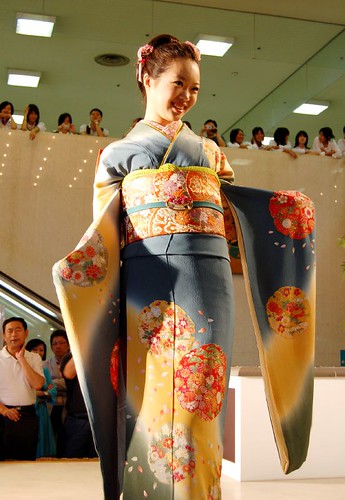 While considered by many as daring, outlandish and provocative, Japanese fashion has come a long way from being just about kimonos and school uniforms. Their eye-popping and flamboyant outfits have largely been influenced by Japan's huge underground club scene. Tokya and Osaka is where Japanese Street Fashion is at its best. By adopting a mixture of current and traditional trends along with foreign and local labels, Japanese youth have created their own unique blend of fashion.
While considered by many as daring, outlandish and provocative, Japanese fashion has come a long way from being just about kimonos and school uniforms. Their eye-popping and flamboyant outfits have largely been influenced by Japan's huge underground club scene. Tokya and Osaka is where Japanese Street Fashion is at its best. By adopting a mixture of current and traditional trends along with foreign and local labels, Japanese youth have created their own unique blend of fashion.
 Japanese street fashion has a variety of trends and styles. Youth were more elaborate in their dressing patterns and make-up. Bright colours, eccentric patterns, hand-made garments, heavy jewellery, mixing and matching jeans and tank tops with traditional wear like kimonos, is their way of making statements about their cultural influences and way of life. Lolita, Kogal, Cosplay, Ganguro are some of the most sought after styles that Japanese youth display on the streets.
Japanese street fashion has a variety of trends and styles. Youth were more elaborate in their dressing patterns and make-up. Bright colours, eccentric patterns, hand-made garments, heavy jewellery, mixing and matching jeans and tank tops with traditional wear like kimonos, is their way of making statements about their cultural influences and way of life. Lolita, Kogal, Cosplay, Ganguro are some of the most sought after styles that Japanese youth display on the streets.
 Lolita is a style with many subcultures, such as Punk Lolita, where chains, beads, lace and wristbands are popular accessories along with pink and peach colour prints. Gothic Lolita focuses on styles emerging from the Victorian age such as dark colours, black make-up, heavy brooches, and ribbons.
Lolita is a style with many subcultures, such as Punk Lolita, where chains, beads, lace and wristbands are popular accessories along with pink and peach colour prints. Gothic Lolita focuses on styles emerging from the Victorian age such as dark colours, black make-up, heavy brooches, and ribbons.
The Ganguro art of dressing is similar to North American youth trying to replicate tanned and blonde celebrities and models. The look consists of light or dark tanned bodies, bleached or dyed hair, summer dresses and platforms. Their exaggerated looks and outfits, is their attempt at westernizing themselves dramatically.
 The Kogal style is where young Japanese women display their wealth through various tastes in music and fashion. Wealthy parents often support young girls who are into this style. They keep themselves up-to-date with Japan's ever-growing mobile technology. They adorn themselves with big boots, skirts pinned very high, dramatic make-up and the latest in American fashion brands. Many see the growth of Gothic Lolita to be a reaction to the materialism desire that emerges with the Kogal trend.
The Kogal style is where young Japanese women display their wealth through various tastes in music and fashion. Wealthy parents often support young girls who are into this style. They keep themselves up-to-date with Japan's ever-growing mobile technology. They adorn themselves with big boots, skirts pinned very high, dramatic make-up and the latest in American fashion brands. Many see the growth of Gothic Lolita to be a reaction to the materialism desire that emerges with the Kogal trend.
 Costume Play, shortened to Cosplay is a trend where dressing of characters from manga, anime, fantasy movies and videogames is encouraged. The Lord of the Rings, Harry Potter and The Matrix series are some Hollywood films which increased the popularity of Cosplay artists. Japanese youth styled in Cosplay attires are often seen at various public gatherings such as amusement parks, nightclubs dedicated to like-minded dressers and many high profile Cosplay parties.
Costume Play, shortened to Cosplay is a trend where dressing of characters from manga, anime, fantasy movies and videogames is encouraged. The Lord of the Rings, Harry Potter and The Matrix series are some Hollywood films which increased the popularity of Cosplay artists. Japanese youth styled in Cosplay attires are often seen at various public gatherings such as amusement parks, nightclubs dedicated to like-minded dressers and many high profile Cosplay parties.




